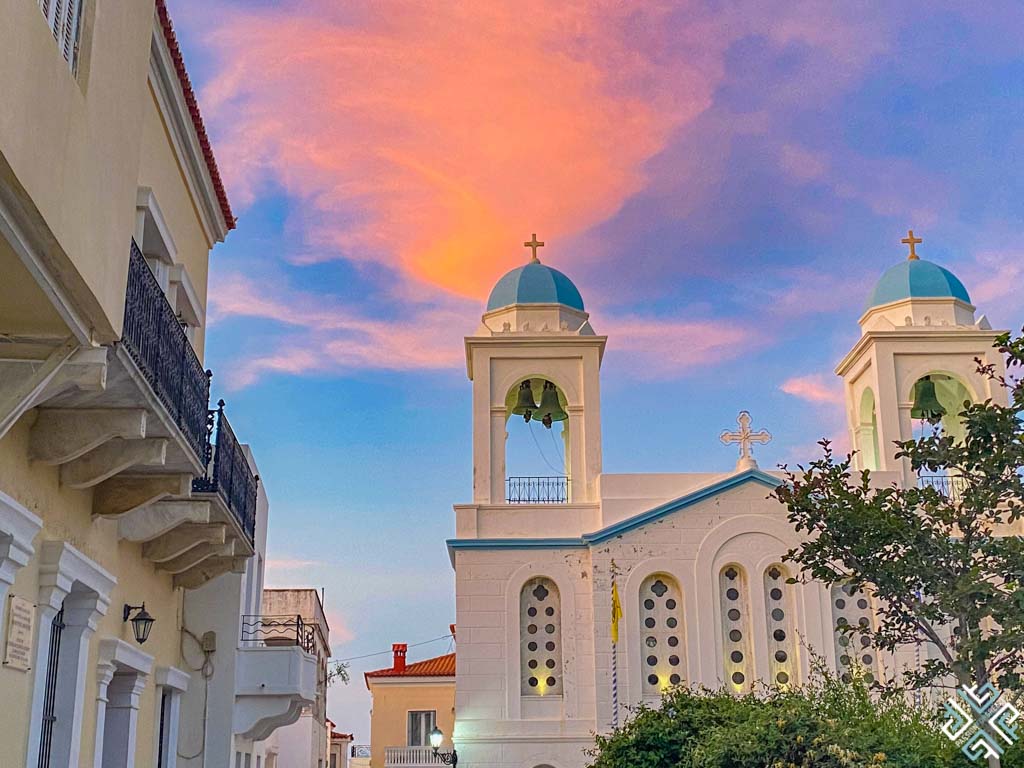Table of Contents
Visiting Manila for the first time? The bustling capital of the Philippines is a vibrant mix of history, culture, and modernity. If you only have 1 day in Manila, don’t worry! This guide is crafted specifically for first-time visitors to help you experience the city’s highlights and immerse yourself in its unique charm. From centuries-old landmarks to delicious local food, this itinerary ensures you make the most of your day if you only have 24-hours in Manila.
How to Get to Manila
Manila is accessible by air, sea, and land, making it a central hub for travelers. Here’s how you can reach the city:
By Air:
- Ninoy Aquino International Airport (NAIA) is the main gateway to Manila, serving both domestic and international flights. It has four terminals connected by shuttle services.
- Major airlines such as Philippine Airlines, Cebu Pacific, and AirAsia offer frequent flights from various global cities.
By Sea:
- Manila is a major port city. The Manila North Harbor services domestic ferries, while the South Harbor caters to international cruise ships.
- This option is ideal for those exploring the Philippines by sea or arriving on a cruise.
By Land:
- From nearby provinces, Manila is accessible via buses, vans, or private cars. Major bus terminals, such as Cubao or Pasay, connect to destinations across Luzon.
- Ride-hailing apps like Grab are widely available in the city for local travel.
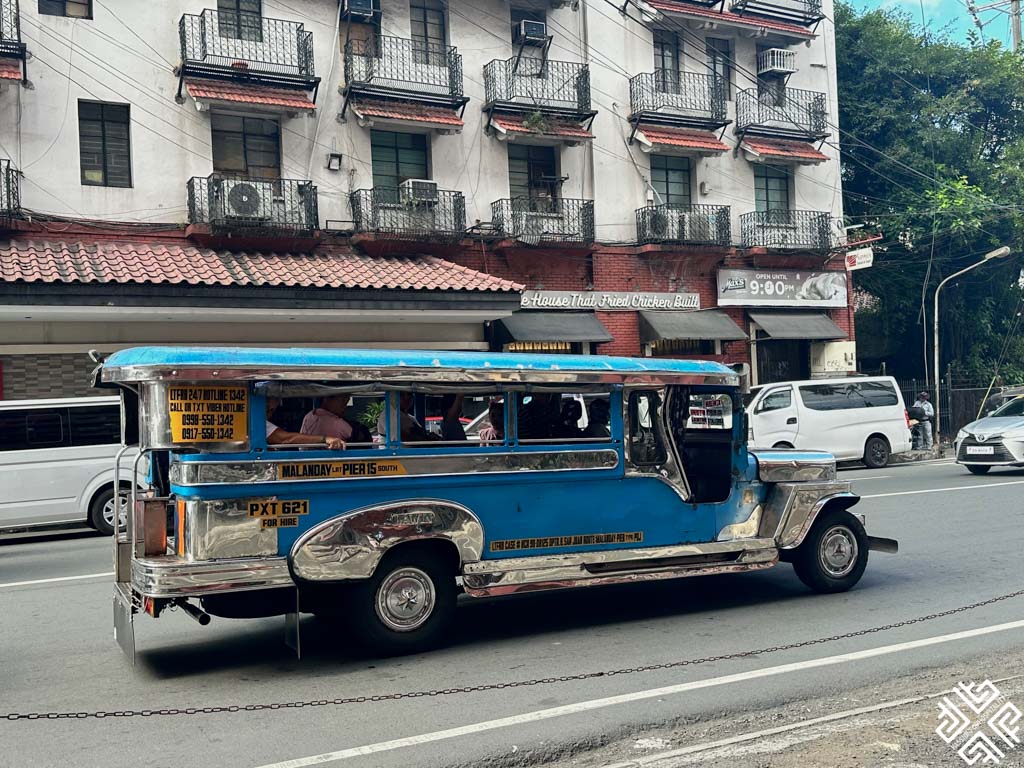
Pro Tip: Traffic in Manila can be unpredictable, so plan your travel time wisely. For first-time visitors, using Grab or booking a private airport transfer for convenience is recommended.
Brief History of Manila
Manila, the capital of the Philippines, is one of the oldest cities in Southeast Asia. Its story dates back to the 13th century when it was a thriving settlement along the banks of the Pasig River. The name “Manila” originates from the term Maynilad, referring to the nilad, a type of mangrove plant that once flourished in the area.
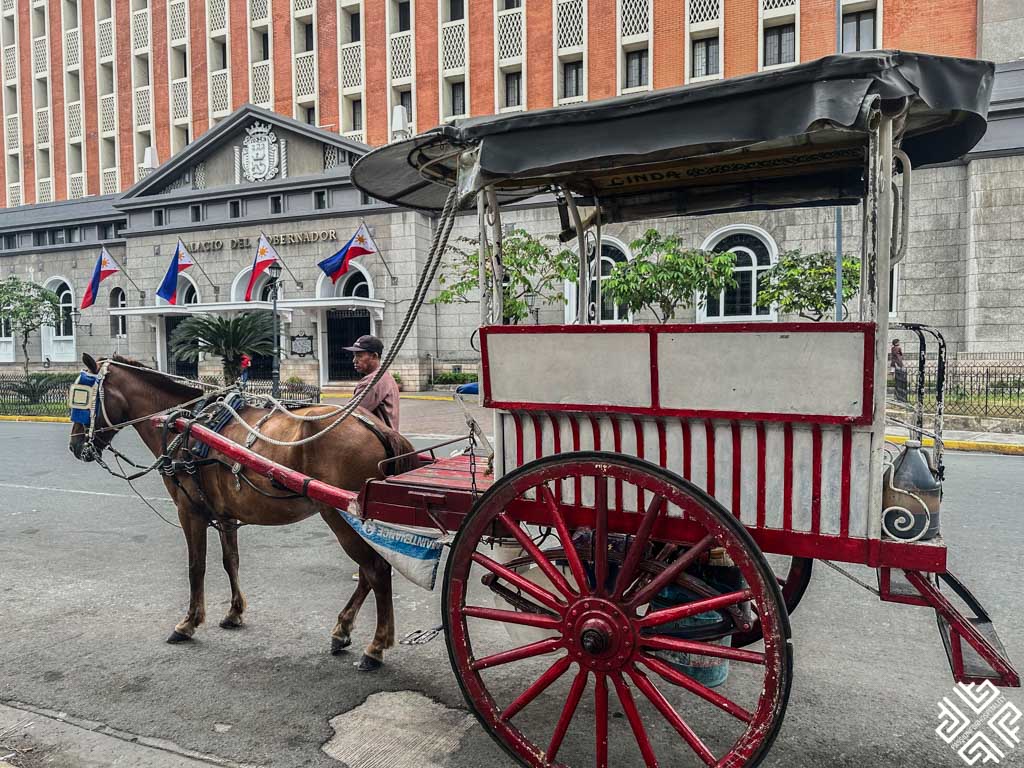
The city was officially established by the Spanish in 1571 under the leadership of Miguel López de Legazpi, making it a pivotal part of Spain’s colonial empire in Asia. Intramuros, the “Walled City,” became the center of political, economic, and religious activities during this era.
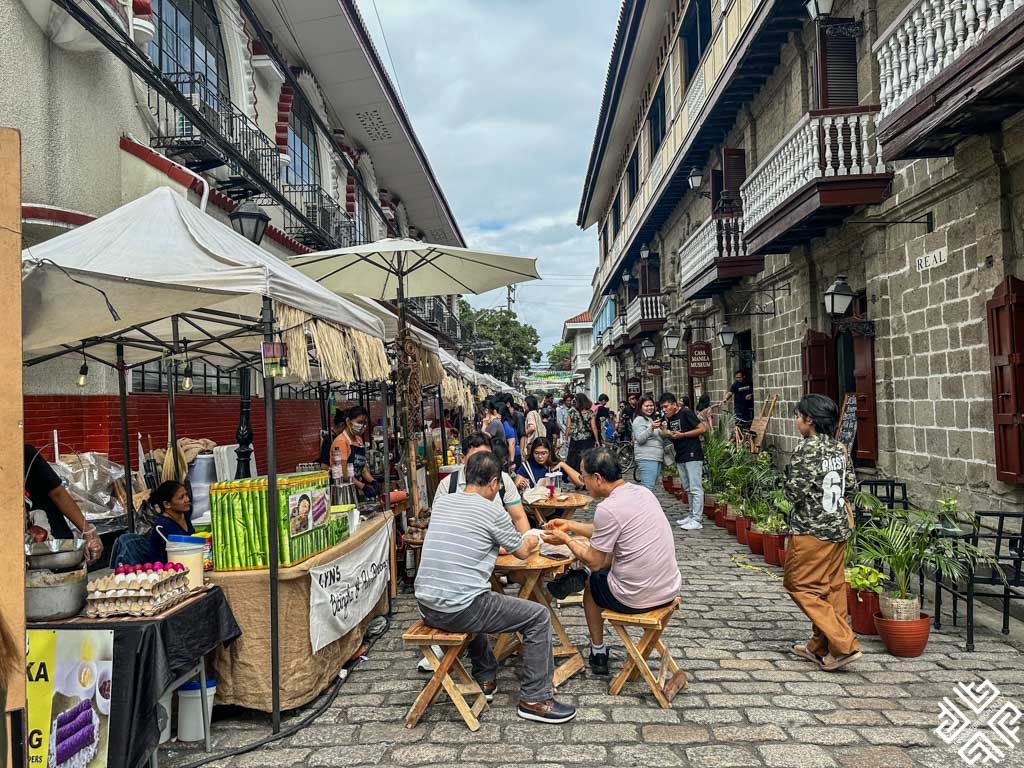
Manila saw significant transformations during American rule in the early 20th century, which brought modern infrastructure, and later endured extensive damage during World War II. Today, it stands as a dynamic metropolis blending history with contemporary urban life.
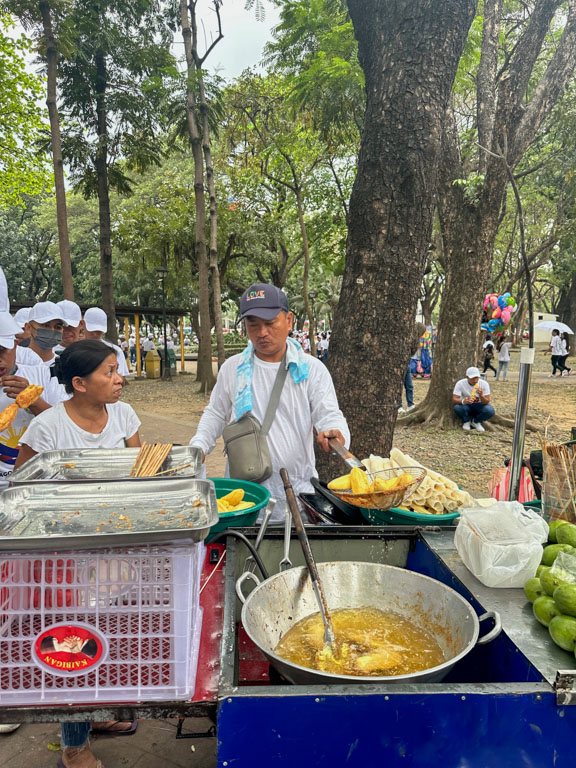
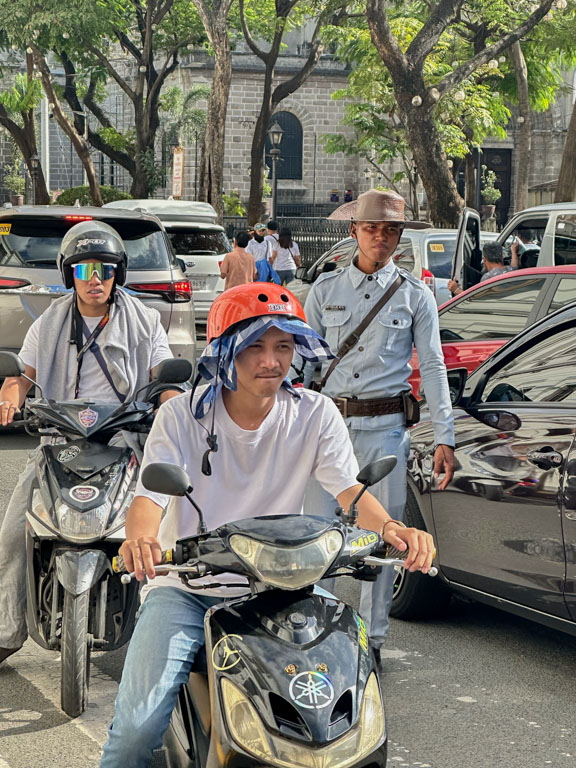
How To Spend 1 Day in Manila
If you only have 24 hours to spend in Manila here are the top recommended things to do. Of course if you are planning to spend more days in Manila – you can explore the city at your own pace. We had a late flight out of Manila therefore we made the most of our day.
Morning: Step Back in Time in Historic Manila
Enjoy Breakfast and Halo-Halo at The Aristocrat Restaurant

We began our day at The Aristocrat Restaurant, a legendary dining spot in Manila known for its sumptuous menu – we came here with our local friends. Start with a hearty Filipino breakfast, such as:
Tapsilog: Marinated beef with garlic rice and a sunny-side-up egg.
Longsilog: Filipino sausage with garlic rice and fried egg.
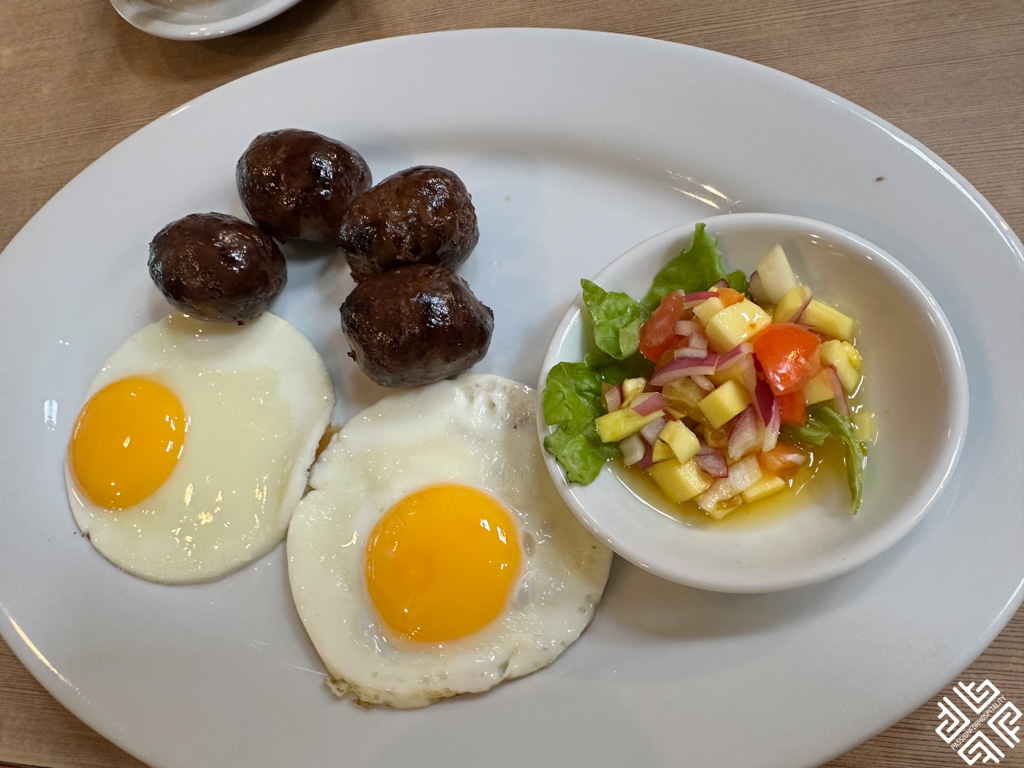

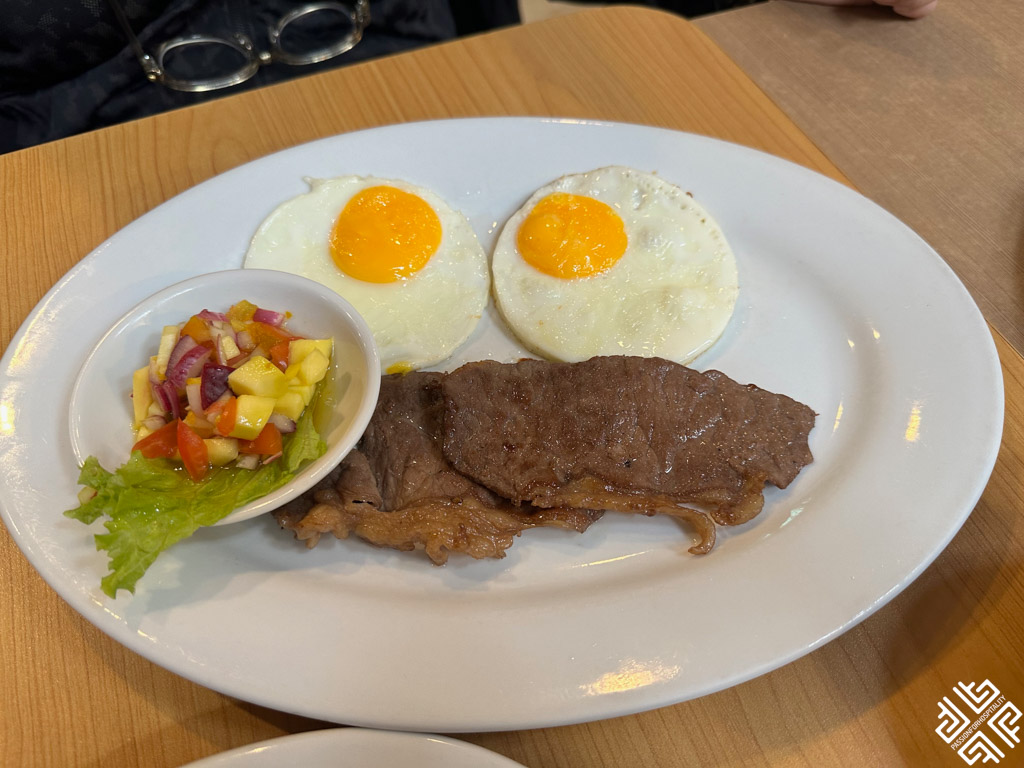
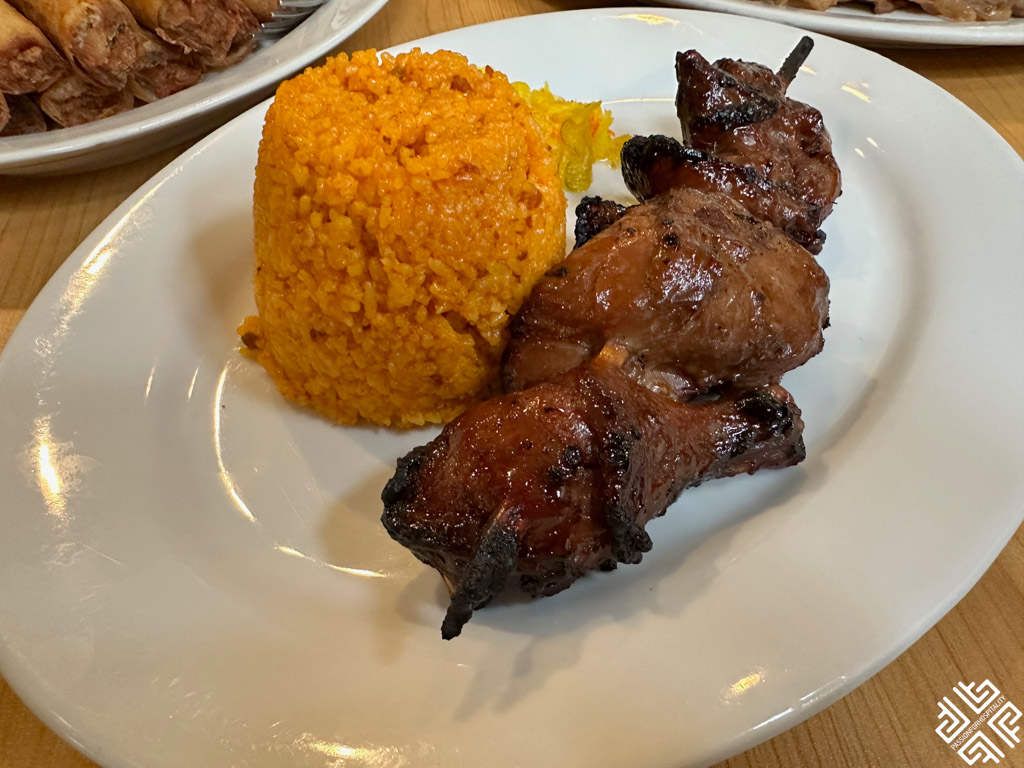

Don’t forget to try their famous Halo-Halo, a quintessential Filipino dessert! This refreshing treat is a delightful mix of shaved ice, sweet beans, jellies, fruits, leche flan, and ube ice cream—a perfect way to cool down before your exploration begins.
Explore Intramuros: The Walled City
After breakfast, we headed to Intramuros, Manila’s historic heart. This Spanish-era fortress is a must-see for first-time visitors, offering a glimpse into the city’s colonial past through a collection of well-preserved landmarks and cobblestone streets.
Key attractions:
Plaza Roma
Plaza Roma is a historic square that exudes the charm and grandeur of Manila’s Spanish colonial past.
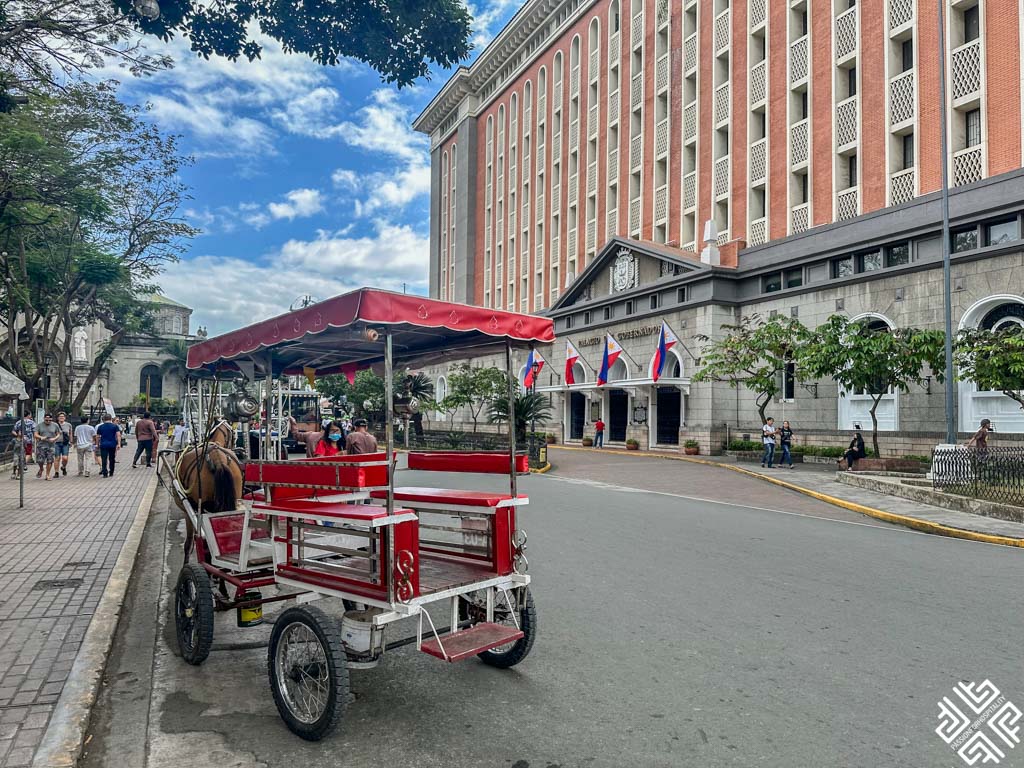
This picturesque plaza is anchored by a bronze statue of King Philip II of Spain, a tribute to the monarch after whom the Philippines was named. Surrounding the square you will find significant landmarks that tell the story of the city’s rich history.

Facing the plaza is the majestic Manila Cathedral, an architectural masterpiece and one of the country’s most important Catholic churches.

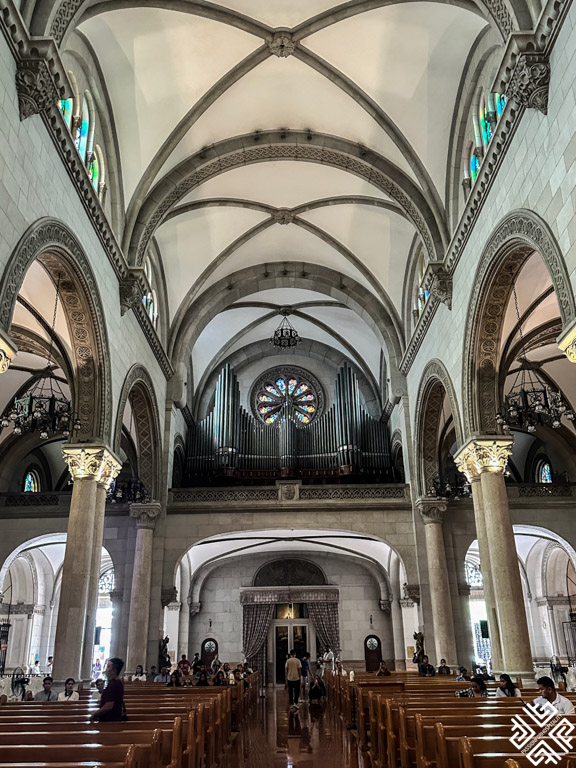
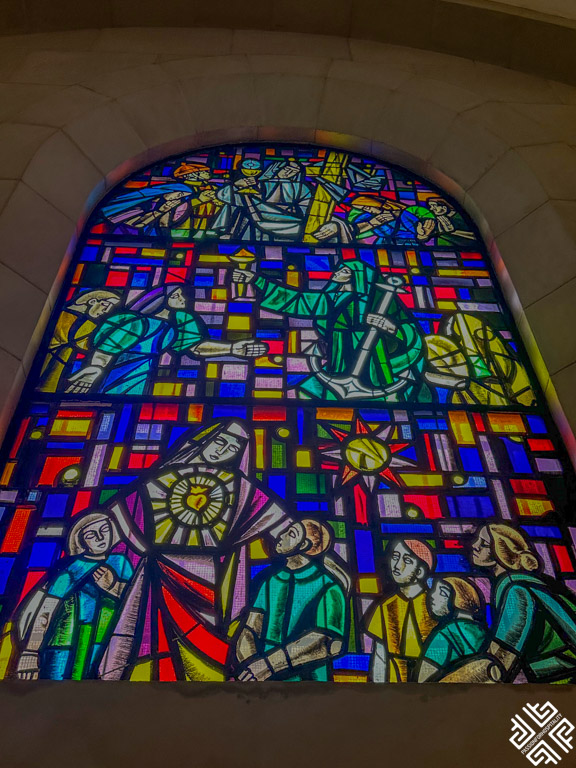
Flanking the square are other iconic structures, including the Ayuntamiento, the old city hall that served as the seat of colonial administration, and the Archbishop’s Palace, which adds to the square’s historical allure. Originally called Plaza Mayor, the square was once a vibrant hub for public gatherings, bullfights, and civic events. Renamed Plaza Roma in 1961 to honor the Vatican and Manila’s status as a leading Catholic city in Asia, the plaza now serves as a peaceful spot where visitors can admire its historical surroundings.
Fort Santiago:
Walk through the gates of this iconic fort, steeped in historical significance. Explore the dungeons and the Rizal Shrine, which pays tribute to Philippine national hero José Rizal.
San Agustin Church:
San Agustin Church, built in 1607, is the oldest stone church in the Philippines and a UNESCO World Heritage Site – it’s absolutely stunning. Located in Intramuros, it is renowned for its Baroque architecture, featuring massive buttresses, intricately carved wooden doors, and stunning trompe-l’oeil ceiling murals by Italian artists. Inside, you’ll find the tombs of notable figures, including Miguel López de Legazpi, Manila’s founder.
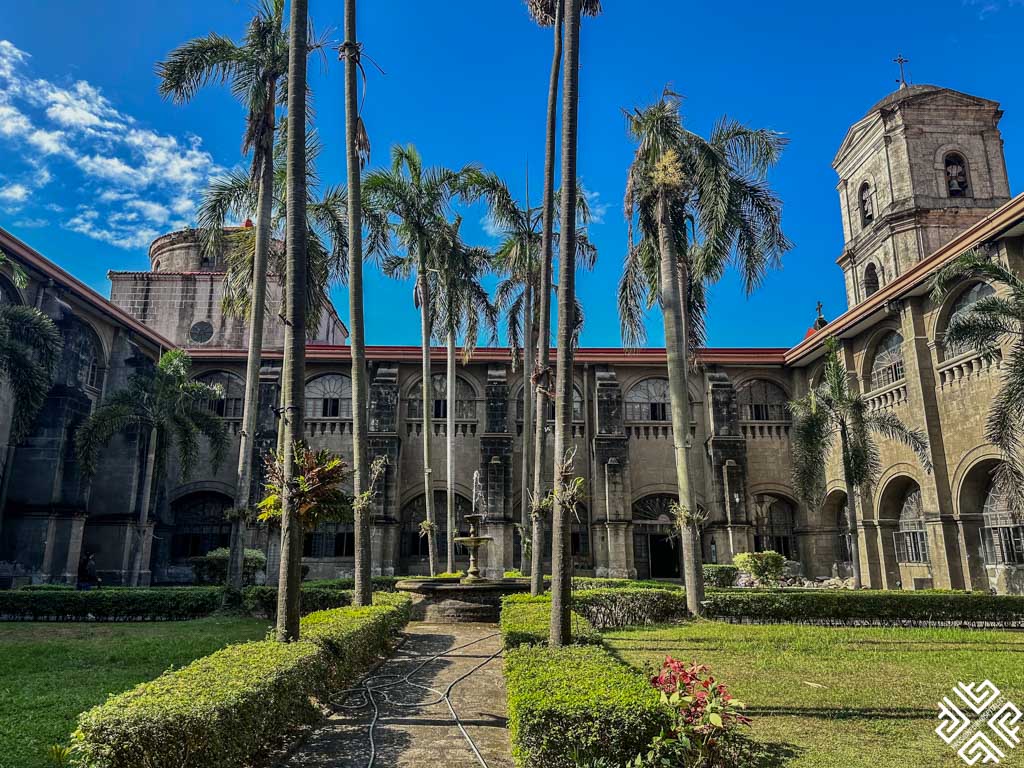
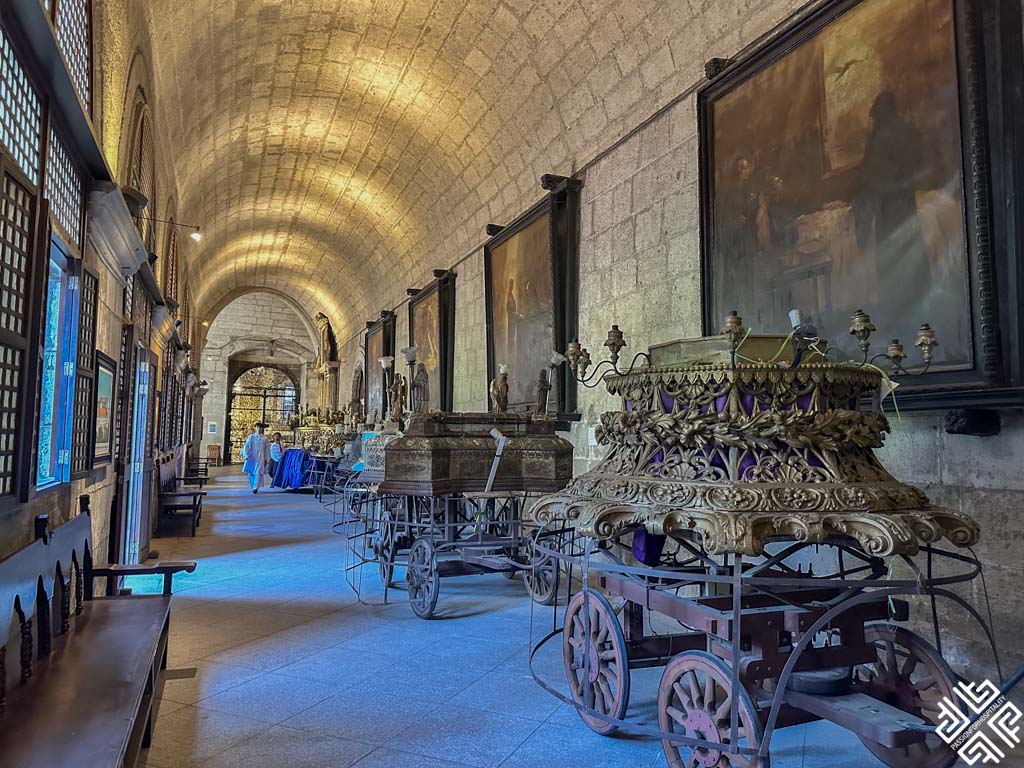
The adjoining San Agustin Museum houses an impressive collection of religious artifacts, colonial artworks, and historical manuscripts. Despite wars and earthquakes, the church has stood resilient, making it one of the few structures to survive the destruction of Intramuros during World War II.

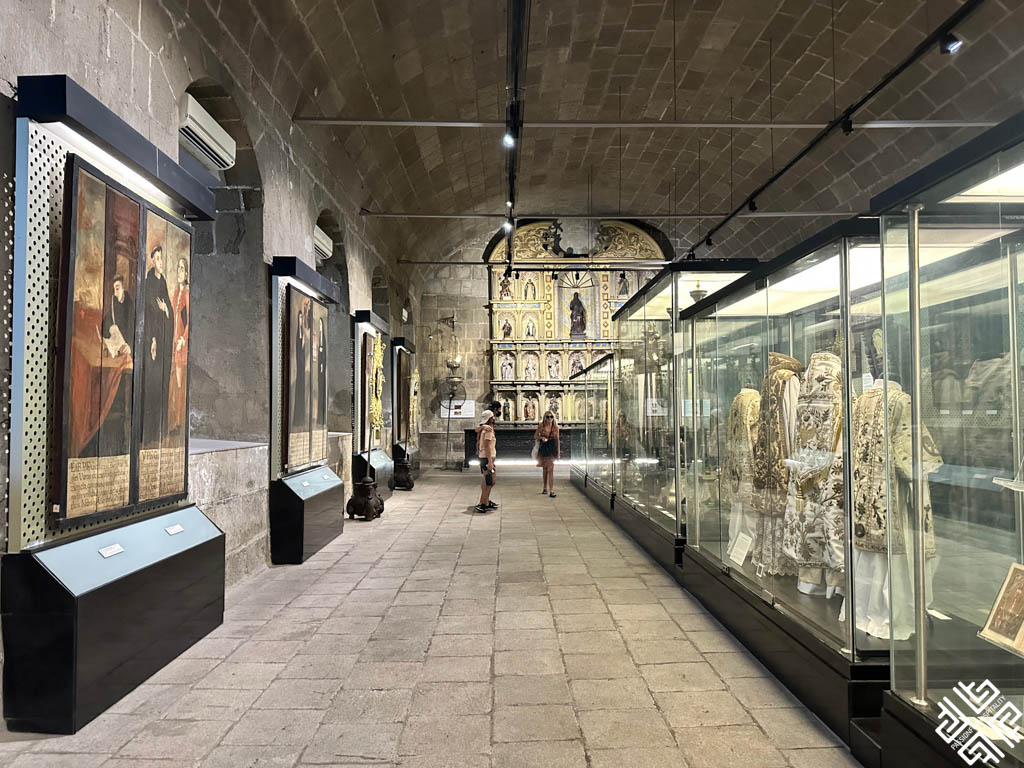


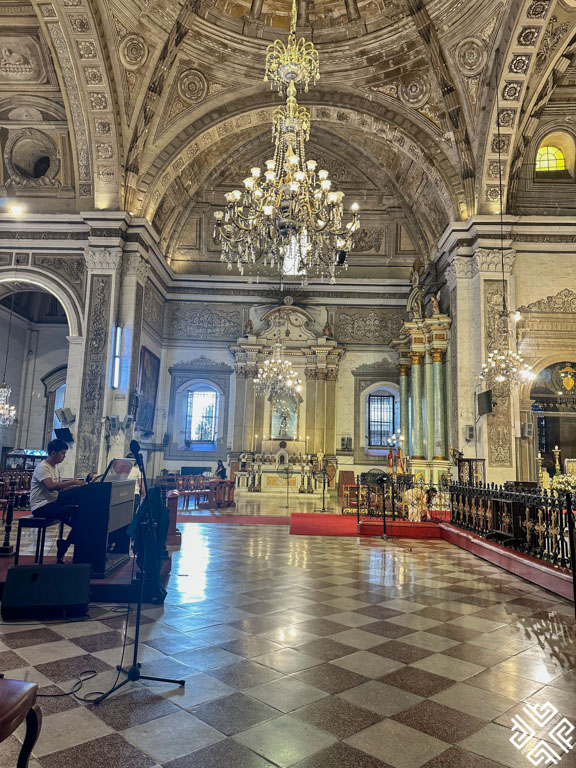
Visiting San Agustin Church offers a glimpse into the Philippines’ rich history and architectural brilliance, making it a must-see landmark in Manila.
Plazuela de Santa Isabel:
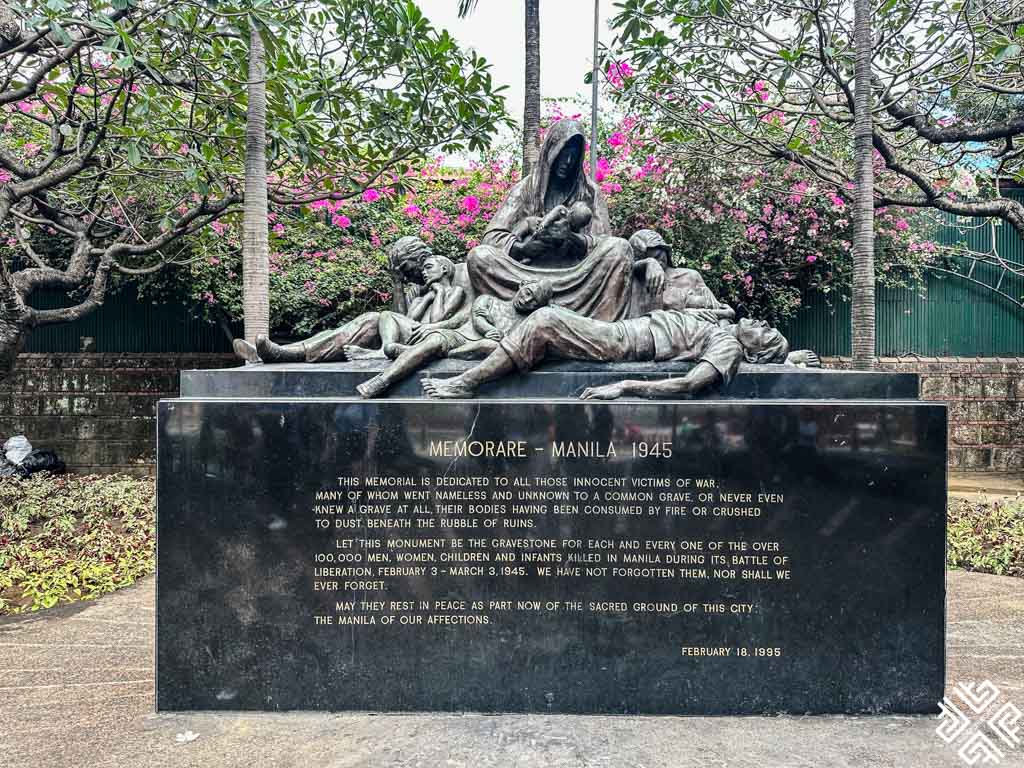
Visit this serene and lesser-known spot in Intramuros, which features a memorial dedicated to civilian victims of World War II. The tranquil atmosphere of this plazuela offers a poignant contrast to the lively streets of Intramuros.
Casa Manila:
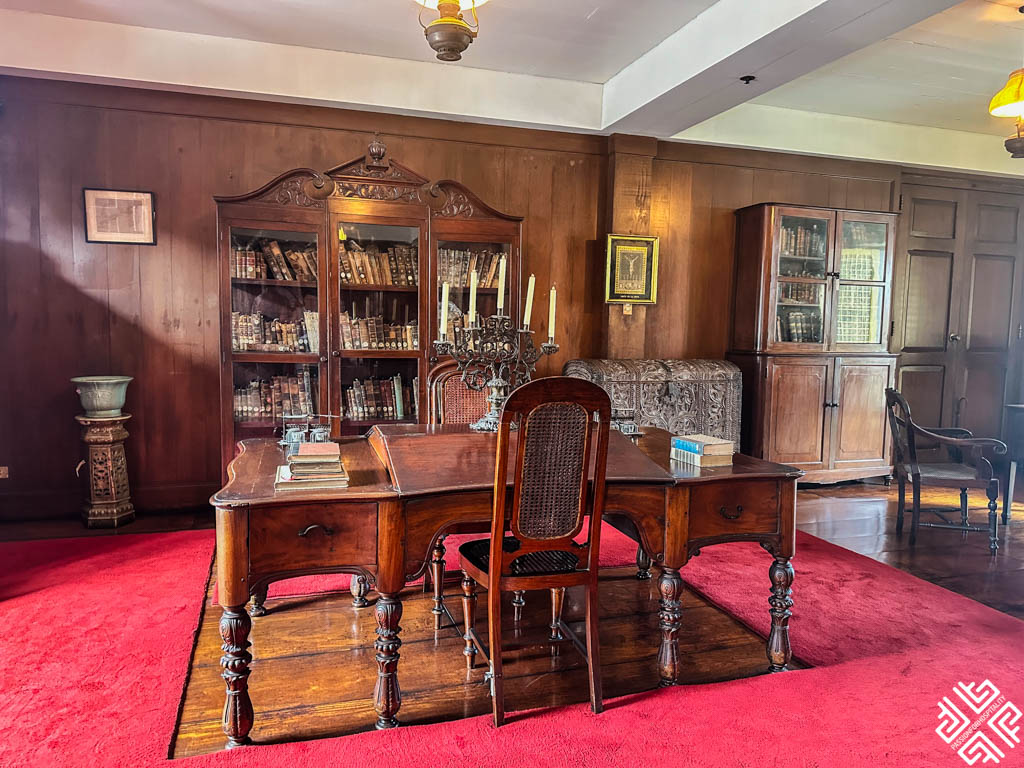
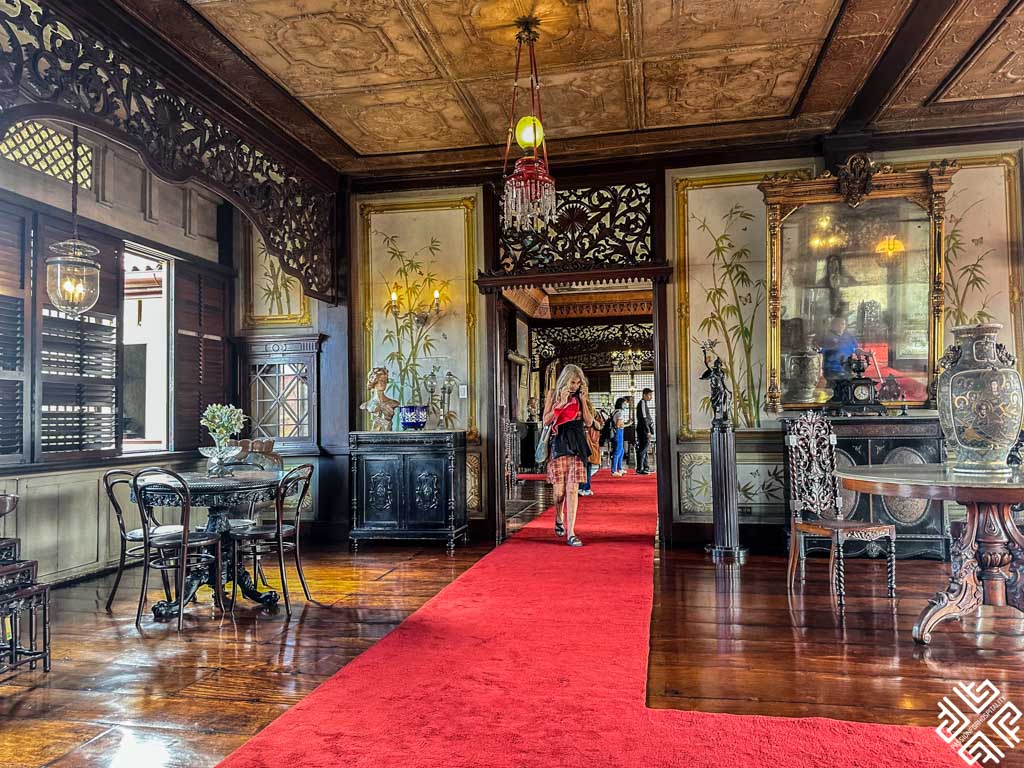
Step into a traditional Filipino house from the Spanish colonial era at Casa Manila. This museum showcases a meticulously restored bahay na bato (stone house) filled with period furniture, textiles, and household items, giving you a vivid glimpse of 19th-century aristocratic Filipino life.
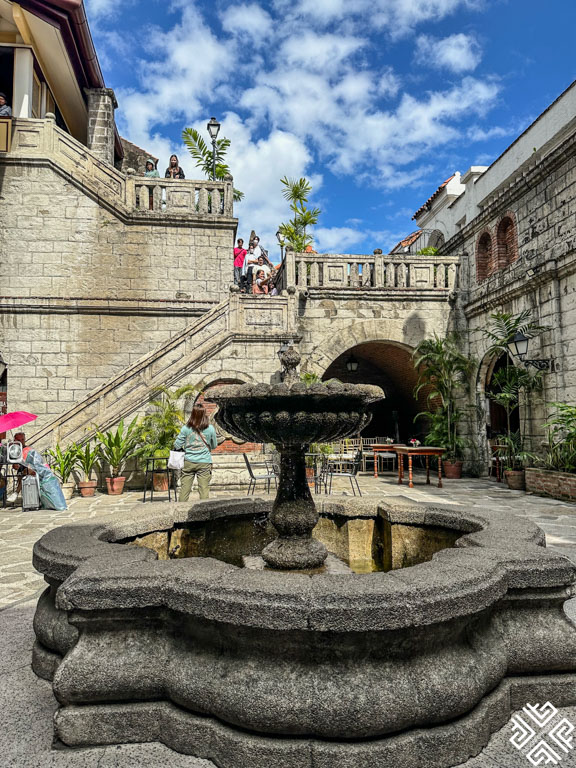

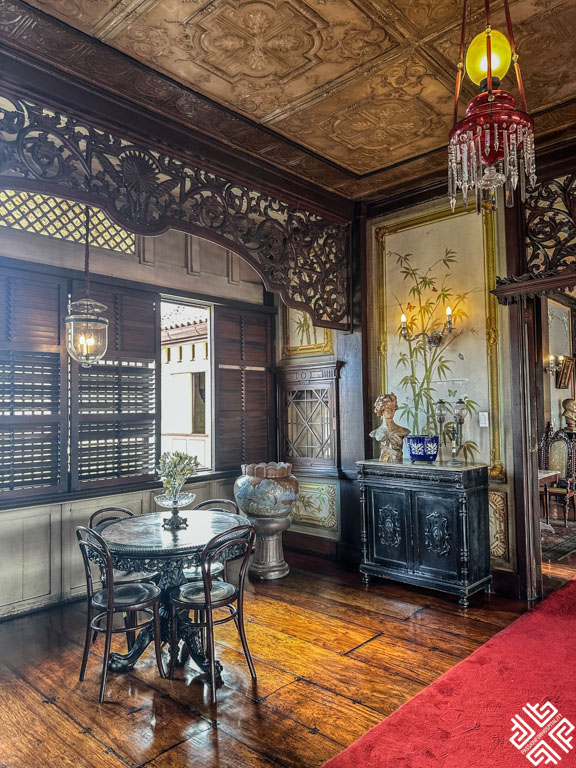
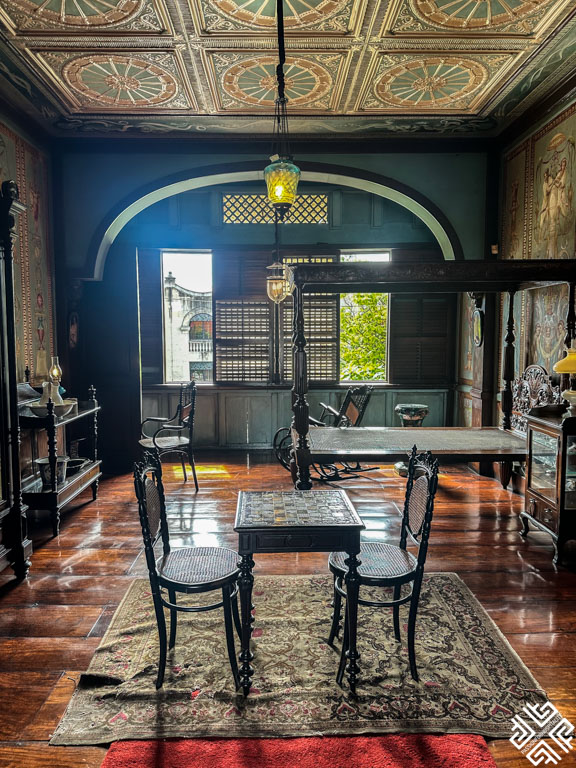


Pro Tip: Opt for a guided city tour or bamboo bike tour to learn fascinating stories about Intramuros’ colonial past, including tales of heroism, culture, and resilience. You’ll also discover hidden corners and lesser-known spots that make Intramuros a unique destination.
Lunch at Barbara’s Heritage Restaurant:
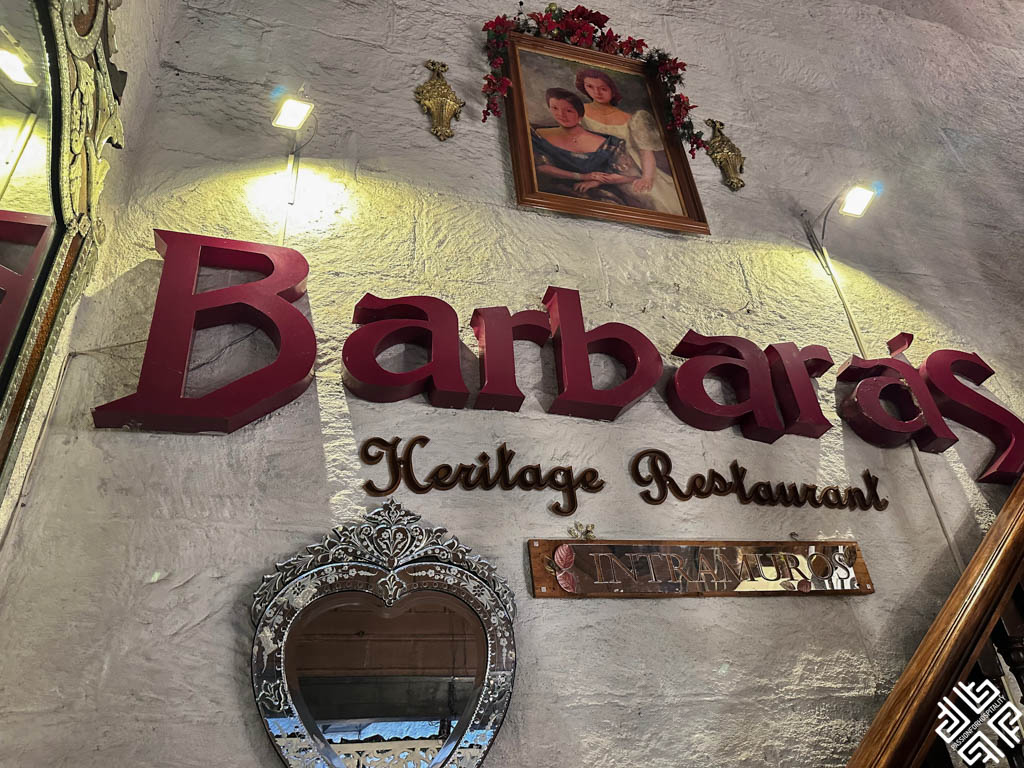
We ended our Intramuros exploration with lunch at Barbara’s Heritage Restaurant. This iconic dining spot offers a delightful menu of traditional Filipino dishes in a colonial-inspired setting.
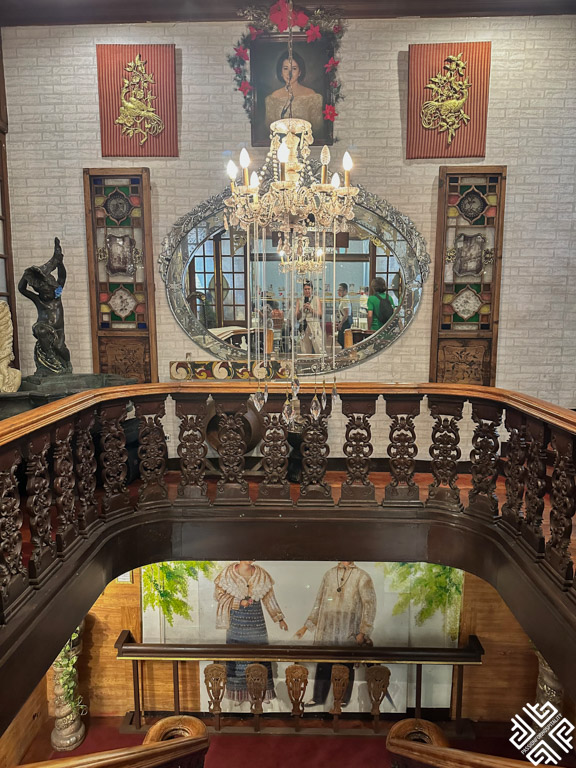
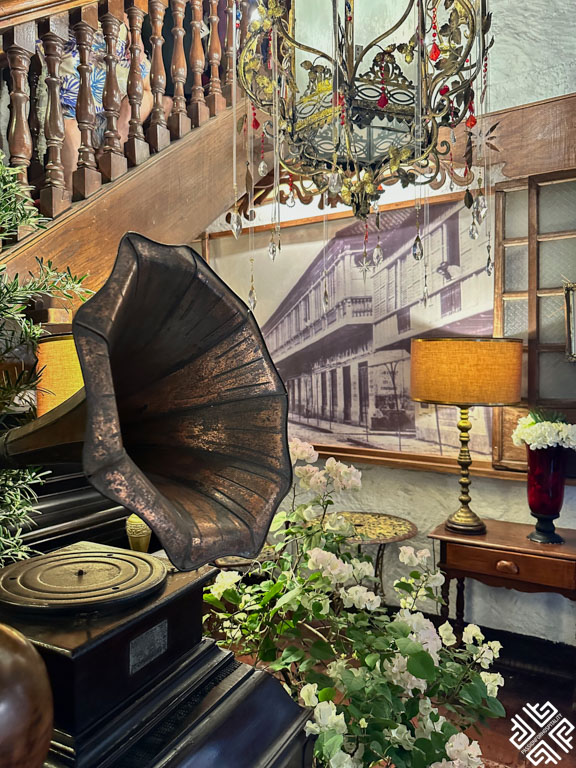
Try their famous kare-kare (oxtail stew in peanut sauce) or adobo (soy-marinated meat), and indulge in the nostalgic ambiance. If you’re lucky, you may even catch a cultural dance performance while you dine!

Or
Taste the Flavors of Manila at the world’s oldest Chinatown
The oldest Chinatown in the world is located in Binondo, Manila, in the Philippines. Established in 1594 by the Spanish Governor-General Luis Pérez Dasmariñas, it was created to serve as a settlement for Chinese immigrants, known as sangleyes, who converted to Catholicism.
Binondo remains a vibrant hub of Filipino-Chinese culture, offering a mix of historical landmarks, traditional shops, and renowned eateries that highlight its rich culinary and cultural heritage. Today, it is a must-visit destination for history buffs and food enthusiasts exploring Manila.
Lunch in Binondo:
Just a short ride from Intramuros, Binondo, the world’s oldest Chinatown, offers a delightful culinary experience. Savor Filipino-Chinese favorites like Lumpia Shanghai (spring rolls), Pancit Canton (stir-fried noodles), and dumplings from Dong Bei Dumplings. For a deeper dive into the flavors, join a food tour.
Quick Stop at Divisoria Market:
After lunch, explore Divisoria Market, a bustling hub for affordable souvenirs and Filipino handicrafts—a perfect spot to find unique mementos.
Afternoon: Immerse Yourself in Manila’s Culture
Visit Rizal Park (Luneta Park)
Rizal Park, also known as Luneta Park, is a sprawling 58-hectare urban oasis and one of the most iconic landmarks in Manila. It’s a symbol of national pride and a peaceful spot in the midst of the bustling city.

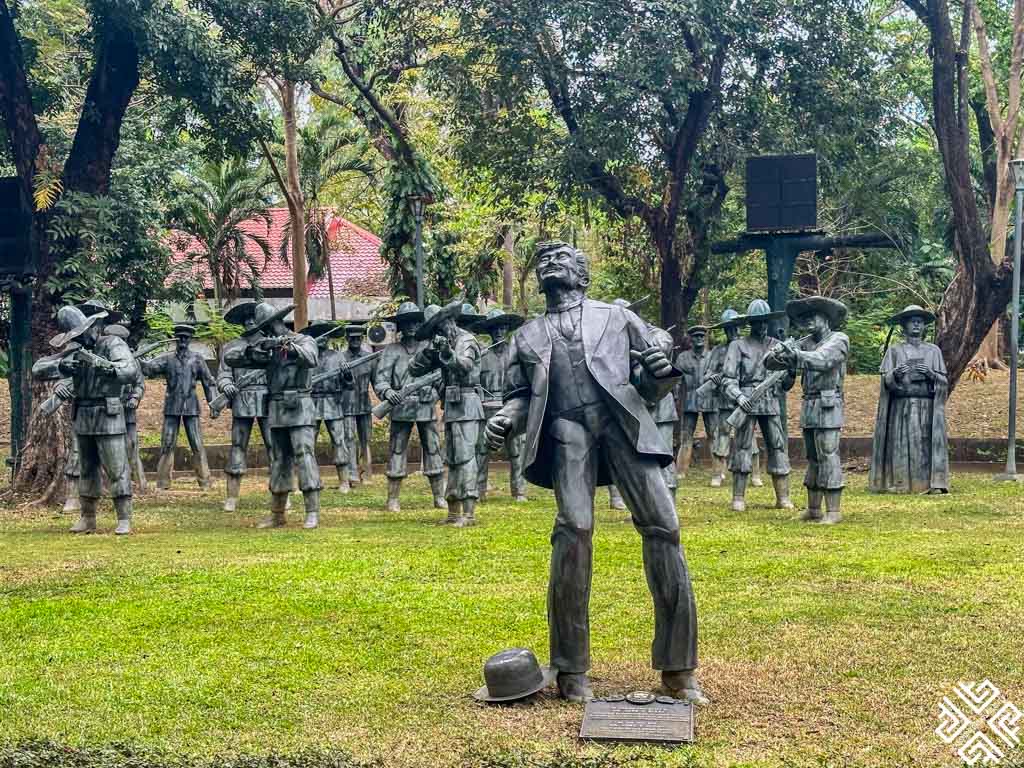


Highlights:
Rizal Monument:
This centerpiece of the park is dedicated to José Rizal, the Philippines’ national hero, who was executed here in 1896. Guarded 24/7 by the Philippine Marine Corps in ceremonial uniform, the monument symbolizes the Filipino struggle for independence.

Independence Flagpole:
Near the monument stands the country’s tallest flagpole, marking the site where the Declaration of Philippine Independence was first raised in 1946.
Gardens and Fountains:
Rizal Park is dotted with themed gardens, such as the Japanese Garden and Chinese Garden, offering serene spots for a leisurely stroll. The central fountains, especially when lit up in the evening, are a visual treat.
Relief Map of the Philippines:
A giant relief map of the Philippine archipelago is displayed in a lagoon, providing an educational and interactive experience for visitors.
Explore the National Museum Complex
Just a short walk from Rizal Park, the National Museum Complex is a cultural haven for history and art enthusiasts. Start with the National Museum of Fine Arts, housed in a grand neoclassical building. Its centerpiece is Juan Luna’s Spoliarium, a massive painting that vividly depicts the grim aftermath of gladiatorial combat in ancient Rome—a powerful allegory for the Filipino struggle under Spanish rule. The museum also showcases masterpieces by other renowned Filipino artists such as Félix Resurrección Hidalgo, Fernando Amorsolo, and Guillermo Tolentino. Each gallery offers a journey through the evolution of Filipino art, from colonial influences to contemporary expressions.
Next, visit the National Museum of Anthropology, which celebrates the rich cultural heritage and diversity of the Philippines. Highlights include the Manunggul Jar, an intricately designed ancient burial jar that reflects early Filipino beliefs about life and death, and exhibits on indigenous craftsmanship, including textiles, tools, and traditional attire. The museum also features a gallery dedicated to the Ifugao Rice Terraces, offering fascinating insights into the ingenuity behind this UNESCO World Heritage Site. Together, these museums provide a comprehensive understanding of the Philippines’ artistic achievements and its deeply rooted cultural identity.
Watch the Sunset at Manila Bay
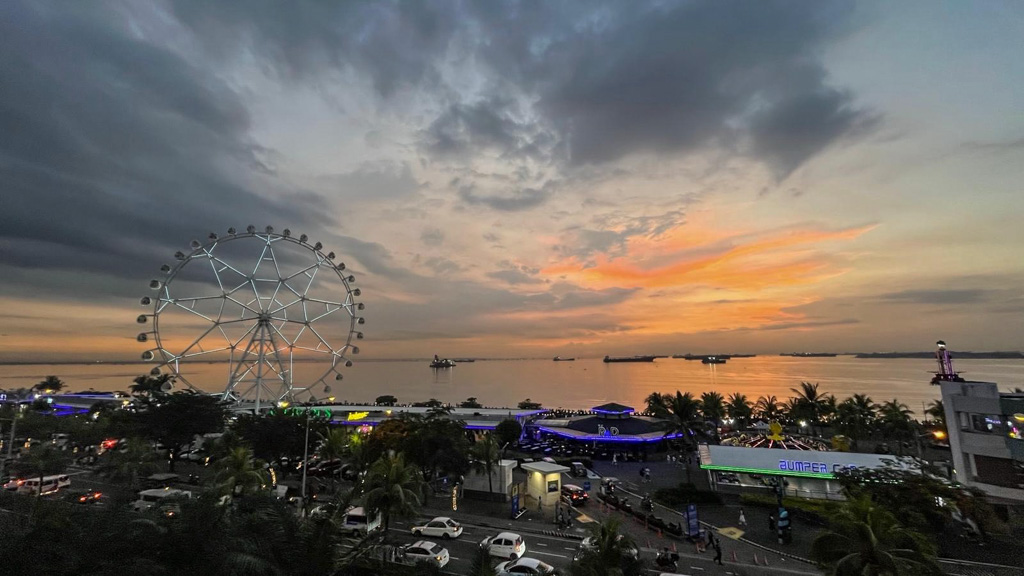
Manila Bay’s sunset is a must-see, renowned for its stunning hues of orange, pink, and purple reflecting over the water. Head to Manila Baywalk along Roxas Boulevard for the best views and a lively atmosphere with street performers and local food vendors. Enjoy a leisurely stroll, savor local snacks like fish balls or banana cue, or opt for a sunset harbor cruise for a unique perspective. Arrive early to secure a good spot, and don’t forget your camera to capture this magical moment of tranquility in the bustling city.
Optional: Evening at SM Mall of Asia
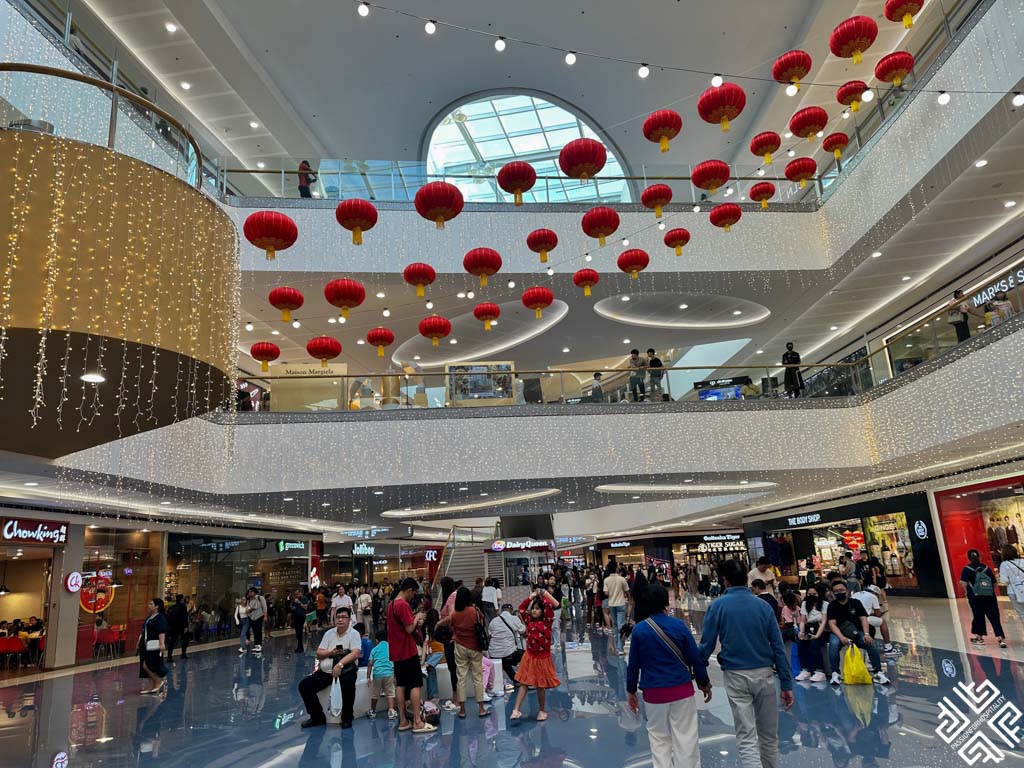
After the Manila Bay sunset, visit SM Mall of Asia (MOA) for a vibrant evening experience. This massive mall is an excellent place to shop for souvenirs and gifts, offering a mix of local and international stores. Enjoy diverse dining options, from Filipino cuisine to global favorites, and unique entertainment like the SM By the Bay Amusement Park with carnival rides and a Ferris wheel, or an indoor ice skating rink. With its lively atmosphere and scenic bay views, MOA is the perfect spot to relax and cap off your day in Manila.
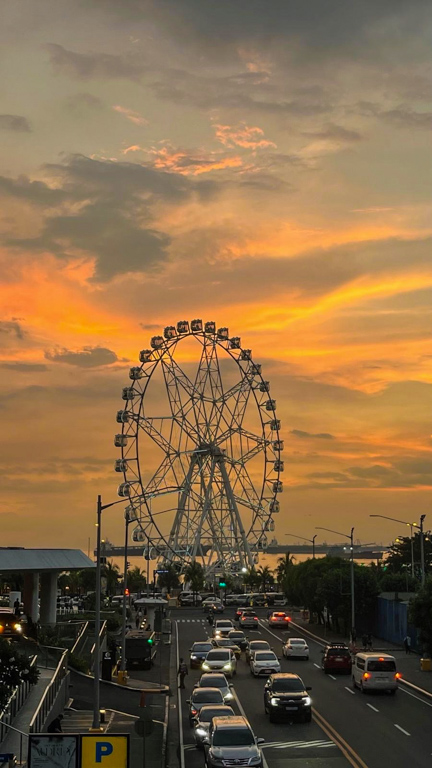
Nightlife or Shopping in Bonifacio Global City (BGC)
If you’re looking to keep the evening alive, head to Bonifacio Global City (BGC), Manila’s sleek and modern business district. Known for its vibrant nightlife, upscale shopping, and cosmopolitan vibe, BGC offers a variety of options for a memorable evening.

What to Do in BGC:
Shop at Bonifacio High Street: Stroll along this open-air shopping and lifestyle hub, lined with trendy boutiques, flagship stores, and local brands. The vibrant atmosphere is complemented by art installations, landscaped walkways, and a mix of dining spots perfect for casual browsing and people-watching.
Recommended Dinner at Terraza Martinez:

For a sophisticated dining experience, reserve a table at Terraza Martinez, a Spanish-inspired restaurant located in BGC. Known for its cozy ambiance and exceptional menu, it offers authentic Mediterranean dishes crafted with fresh, high-quality ingredients. Signature offerings include paella, tapas, and succulent seafood dishes, paired with an excellent selection of wines.
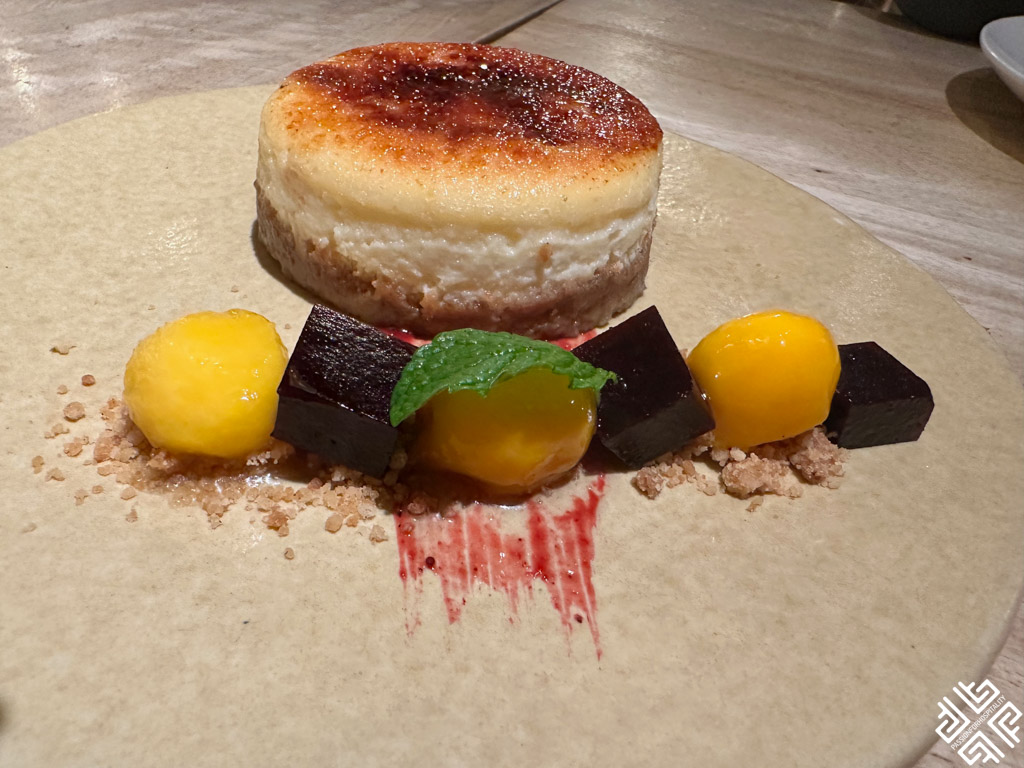
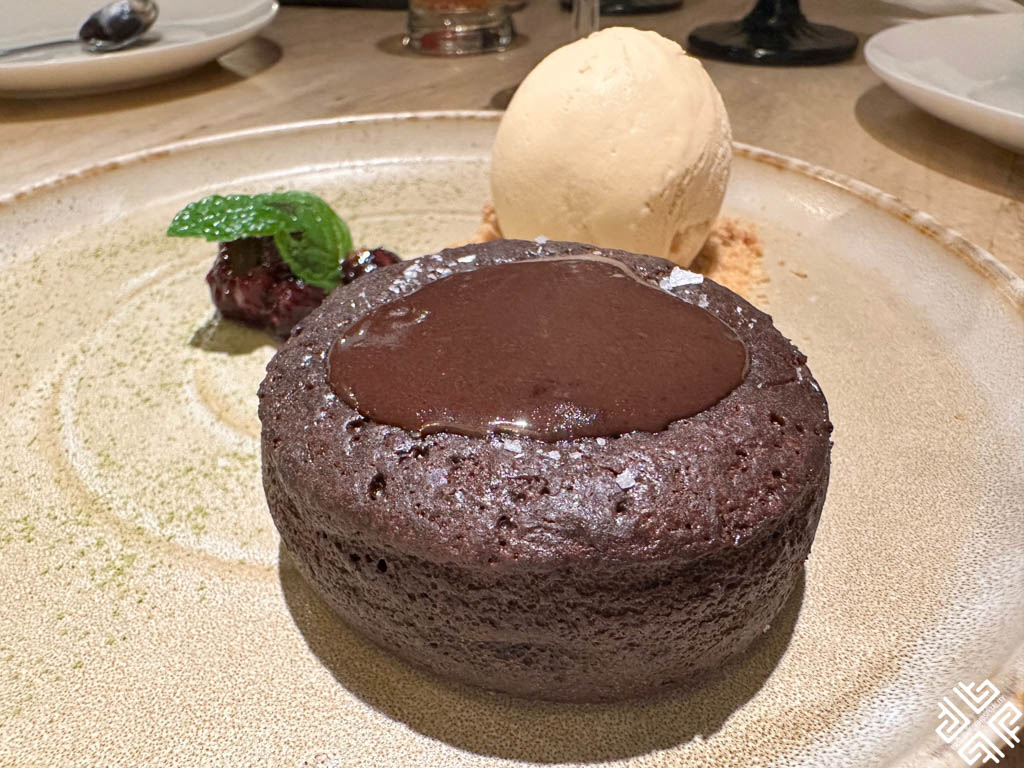
Where to Stay in Manila
Choosing the right accommodation can significantly enhance your Manila experience. Here are four notable hotels catering to various preferences and budgets:
The Heritage Hotel Manila
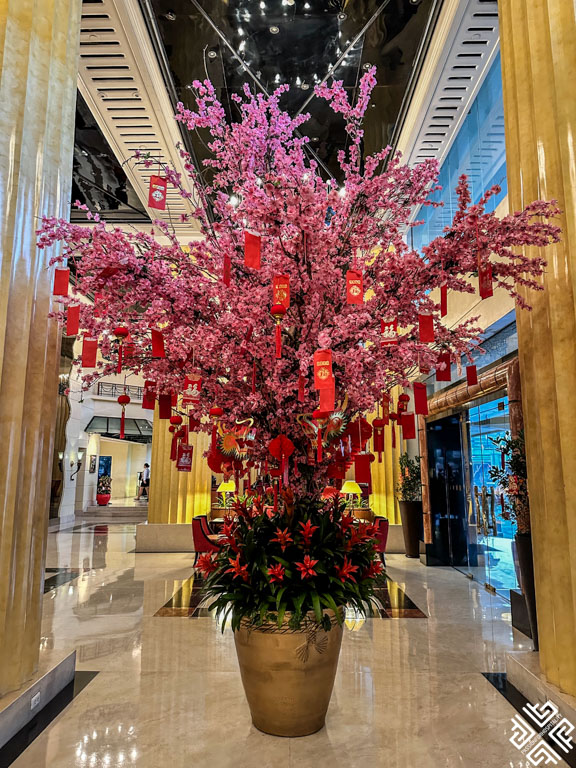

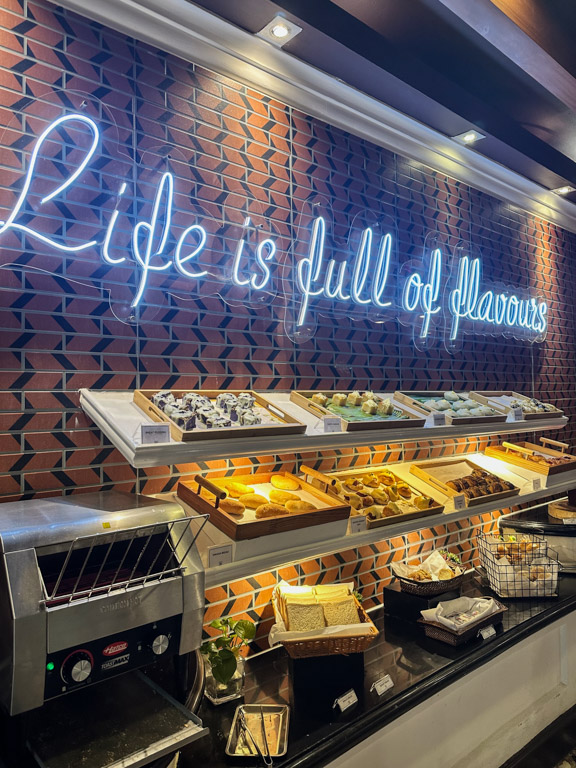

Located along Roxas Boulevard in Pasay City, The Heritage Hotel Manila offers 450 contemporary rooms and suites. Guests can enjoy amenities such as an outdoor pool, fitness center, and multiple dining options. Its proximity to the Mall of Asia and Ninoy Aquino International Airport makes it a convenient choice for travelers.
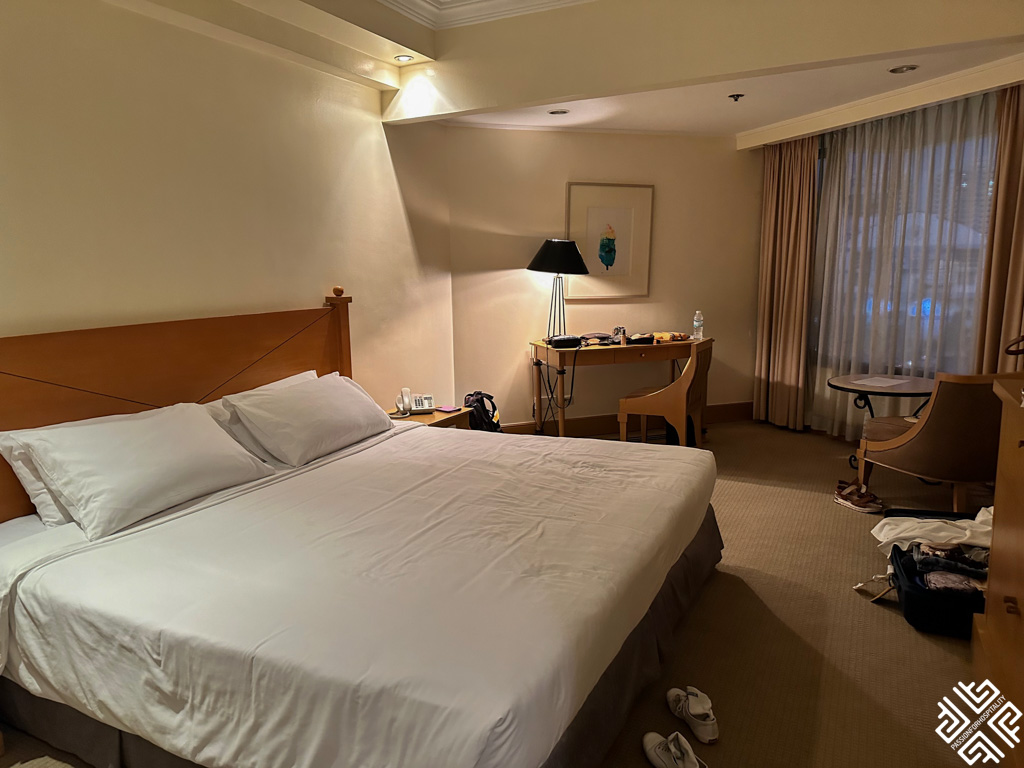
Conrad Manila
Perched on the waterfront, Conrad Manila features sweeping views of Manila Bay and is directly connected to the Mall of Asia. The hotel boasts luxurious rooms, a spa, and several dining venues, making it ideal for those seeking upscale accommodations.
The Peninsula Manila
Situated in the heart of Makati, The Peninsula Manila is known for its elegant design and exceptional service. The hotel offers spacious rooms, a renowned spa, and multiple restaurants, providing a luxurious retreat in the city’s business district.
City of Dreams – Nobu Hotel Manila
Part of the City of Dreams complex, Nobu Hotel Manila offers a unique blend of luxury and entertainment. The hotel features modern rooms, a casino, and the world-renowned Nobu Restaurant, catering to guests seeking a vibrant and upscale experience.
Conclusion
Manila offers a blend of history, culture, and culinary experiences that captivate first-time visitors. From exploring Intramuros to savoring unique dishes in Binondo, this itinerary ensures your one day in Manila is packed with unforgettable memories. Soak up the city’s vibrant spirit and discover why it’s truly the heart of the Philippines!
You might also enjoy these posts:
Cebu Travel Guide: Must-Do Activities for First-Time Visitors
One Day in Bohol: An Unforgettable Itinerary for Adventure
The Ultimate Guide to Siargao: 14 Top Things to Do
PIN FOR LATER!




